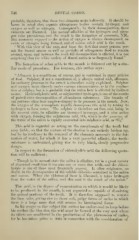Page 736 - My FlipBook
P. 736
746 : DENTAL CARIES.
probable, therefore, that these two elements unite indirectly. It should be
borne in mind that organic nitrogenous bodies contain hydrogen and
oxygen as well as nitrogen. Consequently, by their decomposition, these
elements are liberated. The mutual affinities of the hydrogen and nitro-
gen take precedence, and the result is the formation of ammonia, NH3.
But ammonia exposed to the action of oxygen is always decomposed, an
oxide of nitrogen being formed, and of course nitric acid is the result.
" AVith this view of the case, and from the fact that many persons per-
mit the buccal mucus as well as particles of nitrogenous food to remain
around, upon, and between the teeth till decompo^'ition is effected, it is not
surprising that the white variety of dental caries is so frequently found."
The formation of other acids in the mouth is followed out by a sim-
ilar mode of procedure. For instance, this author says :
" Albumen is a constituent of mucus, and is contained in many articles
of food. Sulphur, if not a constituent of, is always united Avith, albumen.
Its ordinary presence in the mouth is therefore easily explained. Sulphur
and oxygen unite directly under various circumstances, as in the combus-
tion of sulphur, but it is probable that the union here is effected by indirect
means. Hydrosulphuric acid, or sulphuretted hydrogen, is one of the results
of putrefactive decomposition of albuminous substances. The breaths of
our jnitients often bear ample testimony to its presence in the mouth. Now,
the oxygen of the atmosphere rapidly decomposes this acid by taking its
hydrogen to form water. The sulphur is therefore set free, and, being in
the nascent state, its affinities are increased in energy, and it also unites
Avith oxygen, forming the sulphurous acid, SO,, which in the' presence of
the water of the saliva is rapidly converted into sulphuric acid, or SO3"
This acid is regarded as acting on the constituents of the tooth but
very feebly, so that the texture of the dentine is not entirely broken up,
but by its tendency to the removal of the elements necessary to the for-
mation of water, for which it has a very powerful affinity, the tooth-
substance is carbonized, giving rise to very black, slowly progressive
decays.
In respect to the formation of chlorohydric acid the following C[Uota-
tion will be sufficient
" Though in its normal state the saliva is alkaline, yet in a great variety
of abnormal conditions it contains one or more free acids, and the chloro-
hydric is one of those most frequently present. It often originates, no
doubt, in tlie decomposition of the soluble chlorides contained in the saliva
and mucus. When the chlorine of these is liberated, it takes hydrogen
from the water of the saliva, and this acid is the result of the union."
Tliis acid, in the degree of concentration in wliich it Mould be likely
to be produced in tiie mouth, is not regarded as capable of dissolving
the animal ])ortions of the tooth. It is therefore supposed to remove
the lime salts, giving rise to those sofit, pulpy forms of caries in which
there is a large mass that still retains its histological forms.
In his essays on this subject this author lias endeavored to keep before
his readers the idea that the acid must be formed at the very spot where
its effects are manifested in the production of the phenomena of caries,
for he has taken ])ains to state in connection with the consideration of


